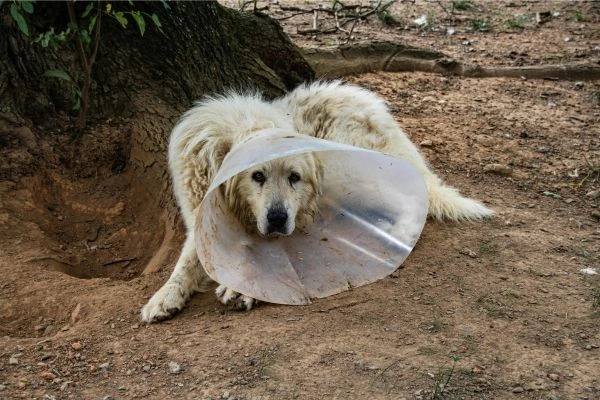Being a pet parent comes with a lot of responsibilities.
Your dogs will rely on you for everything: love, care, food, and safety. It is of utmost importance that you are always ready and geared up for emergencies.
Whether you’re at home or traveling or even out for just a walk in the park, it is essential that you keep a first aid kit at hand always.
The article below lists a series of must haves that should be present in your first aid kit.
Must-Have Items in a Dog First-Aid Kit
1. Digital Thermometer
Dogs have a normal body temperature between 100°F and 103°F. A digital rectal thermometer helps you spot fever or hypothermia quickly. Use a water-based lubricant and only insert gently.
Always keep your dog calm or gently restrained during use. Never use glass thermometers—they can break and injure your pet.
Record their normal temperature when healthy for reference. Clean the thermometer thoroughly after every use.
2. Sterile Gauze Pads & Rolls
Gauze pads are key for covering wounds, absorbing blood, or applying pressure to stop bleeding. Rolls help wrap injured limbs or secure dressings. Always apply gently to avoid worsening an injury.
Sterile gauze minimizes the risk of infection. Keep multiple sizes on hand for different types of wounds. Avoid using human band-aids as they may stick to fur or be chewed off. Replace gauze frequently if it becomes dirty or damp.
See Also:
3. Antiseptic Solution (e.g., Chlorhexidine or Betadine)
Use these to clean wounds and prevent infections. They’re safe alternatives to alcohol or hydrogen peroxide, which can damage tissue. Dilute Betadine until it resembles weak tea before using.
Apply with a cotton pad and avoid letting your dog lick the area. Antiseptics reduce bacteria without stinging. Always rinse off any visible debris before applying. Keep a travel-sized bottle in case of on-the-go injuries.
4. Tweezers
Tweezers are essential for removing splinters, ticks, or embedded debris. Choose fine-point stainless steel tweezers for precision. Grasp ticks as close to the skin as possible and pull straight out to avoid breaking the mouthparts.
After removing anything, disinfect the area. Don’t use your fingers, as squeezing can push bacteria further in. Clean tweezers before and after use. Consider carrying a tick-removal tool for outdoor adventures.
5. Styptic Powder or Pencil
Styptic products help stop bleeding quickly—especially after nail trims or minor cuts. Apply a small amount directly to the bleeding spot and press gently. The powder helps blood clot and reduces mess.
It’s handy for active dogs who snag a nail or paw pad. Never use on deep or large wounds. If bleeding doesn’t stop in a few minutes, seek vet help. Cornstarch is a temporary substitute if you’re in a pinch.
6. Elastic Bandage or Vet Wrap
This self-adhesive wrap keeps gauze in place without sticking to fur. It’s great for stabilizing sprains or covering injuries. Wrap it snugly but not too tight—it can restrict blood flow.
Always check for swelling below the wrap. Replace if wet or dirty. Secure the end with tape or tuck it under itself. This is a safer option than regular adhesive tape for furry bodies.
7. Gloves (Non-Latex or Nitrile)
Use disposable gloves when handling blood, wounds, or medications to prevent infection. Gloves protect both you and your dog. Always have several pairs on hand, especially if traveling.
Change gloves between tasks or if they get torn. Choose powder-free gloves to avoid irritation. Dispose of them properly after each use. Gloves are especially helpful when dealing with unknown substances or suspected infections.
8. Eye Wash or Sterile Saline Solution
Saline helps flush debris from eyes or wounds without irritation. Great for sand, dirt, or chemical exposure. Use a syringe or dropper to apply gently.
Always flush from the inside of the eye outward. Avoid using anything with added preservatives or medications unless vet-approved. A sealed bottle of sterile saline is a must-have in any kit. It’s also safe to rinse irritated skin or cuts.
9. Dog-Specific Medications
Include any regular medications and vet-approved over-the-counter items like antihistamines (e.g., Benadryl for allergic reactions). Label all meds clearly with dosage instructions.
Never substitute human meds unless directed by a vet. Keep pills in child- and pet-proof containers. Check expiration dates regularly. Include medications for motion sickness, mild pain, or digestive support if your dog is prone to issues.
10. Emergency Contact Info & Health Records
Keep your vet’s number, emergency clinic contact, poison control hotline, and a copy of your dog’s medical records in a waterproof folder. This is crucial if someone else needs to treat your pet or in case of evacuation.
Include microchip info and vaccination dates. Store a recent photo of your dog for identification. You can also save digital copies on your phone. Update the records annually.
Common Dog Emergencies & What to Do (Quick Guide)
-
Wound or Cut: Clean with saline, apply antiseptic, bandage lightly. Monitor for signs of infection like swelling or discharge.
-
Heatstroke: Move your dog to a cool place, apply cool (not ice-cold) water, and offer small sips of water. Seek vet help immediately.
-
Tick Bite: Remove tick with tweezers, clean site, and watch for signs like fever or limping. Keep the tick in a sealed bag for ID.
-
Vomiting/Diarrhea: Withhold food for 6–12 hours but keep water available. Reintroduce a bland diet slowly. If symptoms persist, call the vet.
-
Limping or Lameness: Rest your dog, inspect paws for objects or injury, and apply a cold compress if swollen. If no improvement in 24 hours, seek medical advice.
Dogs don’t usually get into trouble.
But it is always safe to have a kit at hand.
Make sure your kit is at a place where everybody has access.
Always consult a vet in case of serious issues or doubts.

Nikita Rout is a passionate content writer at HowItSee.com, where she explores the wonders of animals, nature, and the curious questions that spark our imagination. With a love for research and a knack for simplifying complex topics, she brings clarity and creativity to every article she writes. When she’s not writing, you’ll likely find her reading about animal behavior or coming up with unique pet name ideas.

